
Wine Culture and Information since 2002 - Volume 22
 Wine Culture and Information since 2002 - Volume 22 |
|
Issue 183, April 2019 |
Contents |
|
|
2018: the Year of Italian Wine |
|
Good news for the Italian wine. 2018 has been a particularly favorable year for producers and, in particular, for those who focus their activity on export. Last year, in fact, Italian wine marked an important record as the volume of sales to foreign countries reached an extremely significant result, clearly improving that of 2017. In a period like this, in which the general economic conditions are not exactly “positive”, news like this can certainly be very good to read. Especially because it is about wine and the viticultural field of our country which, in recent years, with regard to sales, has experienced moments that have not exactly been thriving. The news, in addition to highlighting the excellent economic results, also highlights another very important aspect, that is the abroad reputation of Italian wine has increased and consumers recognize a greater value to it, therefore willing to pay the quality they find in the glass. Good news also comes in regard to internal consumption, where sales have shown an increase in favor of the beverage of Bacchus. This is what can be deducted from the figures of a recent survey released by Istat (the Italian Institute of Statistics) and concerning wine exports abroad as well as the report released by Iri about sales recorded in the large-scale retail channel during 2018. As for exports, the last year Italian wine achieved a record in terms of value, more than 6.2 billion euros, with an increase of 3.3% equal to 200 million euros compared to 2017. A result consolidating the good performance of Italian wine abroad, especially when compared to the results of the previous ten years. In 2008, in fact, the export of wine recorded a total value of 3.67 billion euros, and then raised to 5 billion in 2013. These data, however, get a different meaning when compared to the exported volumes which, in 2018, has recorded a 8.1% decline. This means Italy has exported a smaller quantity of wine, however it has been sold at a higher price, a sign of the increased value recognized to Italian wine and the perception abroad of the enological quality of our country. A clearly positive result of which we must be proud of: the unmistakable sign the effort made by Italian producers has allowed the achievement of a significant and tangible increase in overall quality. The smaller quantity exported is also due to 2017 conditions which, in terms of harvested grapes, has been among the most scarce in recent years. The lower production of wine, therefore, has probably limited the economic result and that, perhaps, could have been even more significant. Let's look in detail at the figures emerging from the two researches conducted by Istat and Iri, results concerning – as already mentioned – both exports abroad and domestic consumption recorded in large-scale distribution. The two main countries showing the greatest appreciation for Italian wines – Germany and the United States of America – have both increased, in terms of value, by 4%. Also interesting is the result achieved in France, in which Italian wine exports have even increased by 10.1%. A decidedly significant figure, considering the huge French wine production and which, in this sense, can be considered as a direct commercial competitor of Italy. Another significant figure comes from Australia – an important wine making country – where Italian wine has recorded an increase in sales of 18.5%. Good news also comes from Poland, with an increase of 23.3% and from South Korea, where Italian wine has recorded an increase of 14.6% more in sales than in 2017. Export figures, however, also give some bad news: sales in China and Russia decreased in both cases by 2.4%. Good news also comes from domestic consumption in Italy, where – in 2018 – has been recorded an increase in value of sales and, at the same time, a decrease in volumes. Data collected by Iri in the large-scale retail sector, recorded a sales volume of 1.9 billion euros, equal to an increase of 2.9%. In terms of quantity, more than 619 million liters of wine were sold in 2018, recording a decline of 4.4% compared to 2017. The good news, exactly as for exports, is people recognize greater value to wine and is willing to spend more than in past years. Moreover, according to the study carried out by Iri, in the first few months of 2019 there has been a further increase in sales in terms of quantity, recording an increase of 1.7% and peaks of 5.3% for DOC and DOCG wines. Also according to this research, the overall average price – relative to wine sold in bottles, brik and bag in box – also increased by 7.7%, reaching an average price of 3.07 euros per liter. Things are definitely better for bottled wine reaching an average price of 4.53 euros per liter, with an increase of 4.8%. In the ranking of the large-scale retail trade in our country, the first place goes to Lambrusco, the second one goes to Chianti followed by Montepulciano d'Abruzzo. Excellent results are also achieved by the wines produced with Chardonnay, Barbera, Bonarda and Vermentino grapes. The appellation that has achieved the best result is Lugana, which has succeeded in increasing sales in value terms of 24.2%, equal to 22.1% in terms of quantity. Things went a little less well for Prosecco – a well-known winner of Italian wine in terms of sales – which sees the quantity sold in 2018 decreased by 11.5% corresponding to a decrease of 6.7% in terms of value. In this regard, it should be noted this last data is referred to the total values of the DOC and DOCG denominations concerning wines related to or mentioning “Prosecco”. The results of 2018, both relative to the export and to the domestic market, are in any case a very important signal to the good health of Italian wine. The clear sign the path of enological quality undertaken in the last years in this country has allowed the achievement of obvious and tangible results. Now it's just a matter of consolidating all the good things done so far and to continue walking the journey of quality. So far, so good. Long live the Italian wine! Antonello Biancalana
|
||||
Contrasts of Torgiano Rosso Riserva and GhemmeTwo wines which made the wine making history of their respective territories, mainly made from two magnificent grapes: Sangiovese and Nebbiolo |
|
Wine is a beverage capable of virtually expressing infinite characters and nuances. Result of different factors – all equally indispensable for achieving a specific goal – wine expresses distant sensory profiles even when one of them changes, although they can be considered apparent, superficial or even negligible. Every wine lover will certainly have noticed substantial differences between two wines produced by the same winery and with the same grapes, however coming from different vineyards and distant just a few meters one from each other. The change that is found – sometimes even significant – between one territory and another is one of the many reasons justifying and determining the existence of distinct wine-growing areas. A characteristic that has always fascinated the curiosity of wine lovers since the dawn of the history of wine. It is enough to think about the many documents written by the authors of the past – even dated back to more than a thousand years ago – to understand how the association of wine and territory is a strongly and fundamental principle. The prestige of many areas praised by the authors of the past is still alive today, with unchanged charm, fame and quality. Other areas, on the other hand, can be considered modern, with just a few dozen years of history, discovered – so to speak – thanks to the research and initiative of producers who have accepted the challenge of making quality wines in their own land. A result obtained also thanks to the development of viticultural and enological knowledge that, in the last decades, has benefited from an amazing progress which allowed a better use of varieties and techniques. This month we will focus our attention on wines produced in two distinct viticultural areas – Torgiano and Ghemme – in particular, with grapes having different characteristics and that, in their respective territories, give life to decidedly distant results.
|
|
Torgiano undeniably is the wine-growing area which, in the 1980s and 1990s, allowed Umbria to acquire wine-making fame worldwide. This important territory has also had the merit of changing the concept of quality wine in Umbria, starting a viticultural and enological journey which then influenced the whole region. The main merit must be undeniably recognized to the farsightedness and initiative of Giorgio Lungarotti, a figure of primary importance in the wine history of Umbria and Italy. A path began in the 1960s and that led the territory of Torgiano to obtain in 1968 the status of Denominazione d'Origine Controllata (Controlled Denomination of Origin), which later became “Guaranteed” – DOCG – in 1990. A success mainly achieved thanks to the most famous wine of the territory, Torgiano Rosso, in particular the riserva style, mainly produced with Sangiovese. The potential and fame of Torgiano wines were also known in the past. The Benedictine monks, in fact, were aware of the wine quality of Torgiano, and they have witnessed it in their writings. The importance of the vine and wine in the territory of Torgiano is also evidenced by the regulations for the protection of the vineyards established in the Municipal Statutes of the fifteenth century. In fact, these regulations provided for severe penalties to anyone who caused damage to vines. Torgiano Rosso Riserva – the wine we will examine in the tasting by contrast of this month – is mainly produced with Sangiovese which, according to the current production disciplinary, can also be used alone. This wine provides, for a maximum of 30%, the use of other red berried varieties allowed for the cultivation in Umbria. The production disciplinary also requires Torgiano Rosso Riserva to be aged for a minimum of three years, of which at least 6 months in bottle. It should be noted that, in most of the cases, the aging is done in casks or barriques.
|
||||
|
Ghemme undoubtedly is the king of wines produced in the province of Novara, the only one to have reached the status of Denominazione d'Origine Controllata e Garantita (Denomination of Controlled and Guaranteed Origin), the top of the Italian quality system. This prestigious wine is made with one of the most celebrated grapes of Piedmont – Nebbiolo, here called Spanna – to which can be added, according to the production disciplinary, Vespolina and Uva Rara for a maximum of 15%. In this regard, it should be noted Vespolina is also called Ughetta and Uva Rara is known as Bonarda Piemontese. Ghemme acquired the status of Denominazione d'Origine Controllata (Denomination of Controlled Origin, DOC) in 1969, therefore promoted to the “Garantita” status (DOCG) in 1997. This Novarese wine has a very long history and the first written mentions date back to the time of the ancient Romans. From the 1400s – and until the 1700s – the success of Ghemme was determined by the trading with the nearby Milan, mainly appreciated by the Sforza court and noble families of the Milanese city, therefore becoming a wine also sold by taverns. This commercial success continued also in the 1800s, a period during which new wineries involved to the production of Ghemme were established, with qualitative results appreciated both in Italy and abroad. Today the production of Ghemme has decidedly decreased when compared to other wines of Piedmont, however its quality and the particular expression given both by the soil and local climate, as well as by Nebbiolo, make it a wine of extraordinary personality. According to the production disciplinary, as already mentioned, Ghemme is produced mainly with Nebbiolo – for a minimum of 85% – and, despite the traditional addition of Vespolina and Uva Rara grapes, alone or together, many producers today tend to use 100% Nebbiolo. Ghemme is required by law to age for a minimum of 34 months, of which at least 18 in barrels followed by a minimum of 6 months in bottle. Ghemme is also produced as riserva style and requires a minimum of 46 months of aging, of which at least 24 in cask.
|
The wines of the tasting by contrast of this month share a common enological characteristic: they are both aged in wooden containers, that is casks and barriques. The production disciplinary of Torgiano Rosso Riserva and Ghemme in fact provide for a long aging period and this is in fact done by using casks. As for Torgiano Rosso Riserva, our choice is in favor of a wine produced with 100% Sangiovese, choosing a bootle from the most recent vintage commercialized by the producers. The choice of Ghemme will follow the same principle, that is by favoring a bottle produced with 100% Nebbiolo, by considering in this wine can also be used Vespolina and Uva Rara, therefore we will pick a Ghemme produced exclusively with Nebbiolo grape. Also in this case we will choose a bottle belonging to the most recent vintage commercialized by the producers of this territory. The wines are poured in tasting glasses at a temperature of 18 °C. (65 °F) Let's pour the two wines into their respective tasting glasses and start the evaluation from their appearance, that is color and transparency. The first wine we examine is Torgiano Rosso Riserva. Sangiovese, just like Nebbiolo, is a variety having a moderate coloring power, therefore its wines generally have a moderate transparency. Let's tilt the glass over a white surface and observe the wine at the base: the color is bright and intense ruby red, with a moderate transparency, confirming the grape with which it is produced. In fact, if we place an object between the glass and the white surface, this is pretty visible. Nuances of Torgiano Rosso Riserva – observed towards the opening of the glass, where the wine becomes thin – shows a garnet red color. Let's now pass to the evaluation of Ghemme, by tilting, also in this case, the glass over the white surface. Nebbiolo, like Sangiovese, produces wines of moderate transparency, a characteristic that is clearly evident in Ghemme as well. The color of the Piedmontese wine is brilliant ruby red and its nuance shows a garnet hue. The aromas perceived in wines produced with Sangiovese and Nebbiolo often have common characteristics, yet definitely distant. In both cases it is possible to perceive aromas of red-fleshed fruit and flowers, especially violet and rose. The differences are however evident and expressed in terms of intensity and quality, in particular, they develop even more distant olfactory profiles in case of the aging in wood. This is what we find in the glasses of the wines of the tasting by contrast of this month, a wine making characteristic on which we must pay attention. Torgiano Rosso Riserva and Ghemme are wines suitable for the long aging in bottle, capable of undergoing long times in cask, therefore also the time factor plays a decisive role in defining the respective aromas. The sensations recalling fruits in common to both varieties are cherry, raspberry and plum, with substantial differences in terms of quality and intensity. As for common floral sensations, in Sangiovese and Nebbiolo we can mainly perceive violet and rose. Let's now pass to the evaluation of the olfactory profiles of Torgiano Rosso Riserva and Ghemme, starting from the wine produced in Umbria. As usual, the first aspect we will examine is the opening, that is the first olfactory sensations the wine gives to the nose. To do this, we hold the glass in vertical position and, without swirling, we proceed with the first smell. Torgiano Rosso Riserva expresses to the nose intense aromas of black cherry, plum and violet. Let's now proceed with the swirling of the glass – operation that will favor the development of aromas – and do another smell. The profile of the wine is completed with raspberry, blueberry, blackberry and rose, to which follow the tertiary sensations, conferred by the maturation of the wood, of chocolate, tobacco and vanilla. Let's move on to the evaluation of the opening of Ghemme, proceeding with the first smell and holding the glass in vertical position. To the nose are perceived aromas of cherry, plum and violet, in some respects, fuller than Torgiano Rosso Riserva. After having swirled the glass, the profile of Ghemme is completed with rose and raspberry, followed by the sensations conferred by the aging in wood of vanilla, cocoa, tobacco and cinnamon. Let's proceed with the evaluation of the gustatory profiles of the wines of the tasting by contrast of this month, starting – as in the previous phases – from Torgiano Rosso Riserva. The first gustatory aspect we evaluate is the attack, that is the first sensations perceived in the mouth at the first sip. In the Umbrian wine are perceived in the mouth a good structure and the moderate astringency of tannins, well supported by a pleasing acidity, typical characteristics of wines produced with Sangiovese. Moreover, in the mouth are also perceived flavors of black cherry, plum and raspberry, therefore confirming the good correspondence to the nose. Let's now take a sip of Ghemme in order to evaluate the attack of the Piedmontese wine. In the mouth is perceived an evident astringency – decidedly more intense than Torgiano Rosso Riserva – with a full body and followed by the typical crisp sensation given by the acidity of Nebbiolo. Also in this case the correspondence to the nose is very good: in the mouth are well perceived the flavors of cherry, plum, raspberry and blueberry. The last phase of this month's wine tasting is about the evaluation of the final sensations perceived in the mouth after swallowing, in particular the taste-olfactory persistence, one of the most important quality factors. The finish of Torgiano Rosso Riserva is characterized by an excellent taste-olfactory persistence, leaving in the mouth the pleasant sensation of structure combined with the crispness of Sangiovese and the roundness given by time. We will also perceive the flavors of black cherry, plum and raspberry. The finish of Ghemme also expresses an excellent taste-olfactory persistence and lasts for several seconds. It can also be perceived the robust sensation of structure and the intensity of astringency – evidently more intense than Torgiano Rosso Riserva – as well as the typical crispness given by the acidity of Nebbiolo. In the mouth insist the flavors of cherry, plum and raspberry, of good and evident intensity. Finally, take another sip of both wines, operation that will allow us to highlight their respective differences, especially in terms of astringency of tannins, roundness and acidity.
|
||||||||
Wines of the Month |
|
|
|
Score legend Prices are to be considered as indicative. Prices may vary according to the country or the shop where wines are bought |
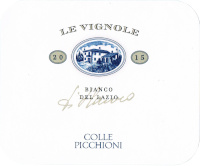
|
|
Le Vignole 2015 |
|
| Colle Picchioni (Latium, Italy) | |
 Malvasia Puntinata (60%), Sauvignon Blanc (40%) Malvasia Puntinata (60%), Sauvignon Blanc (40%) | |
| Price: € 12.50 | Score: |
 Brilliant golden yellow and nuances of golden yellow, very transparent. Brilliant golden yellow and nuances of golden yellow, very transparent. Intense, clean, pleasing, refined and elegant, starts with hints of
quince, apricot and pineapple followed by aromas of citrus fruits, acacia,
pear, peach, jasmine, plum, hawthorn, saffron and hints of vanilla. Intense, clean, pleasing, refined and elegant, starts with hints of
quince, apricot and pineapple followed by aromas of citrus fruits, acacia,
pear, peach, jasmine, plum, hawthorn, saffron and hints of vanilla.
 Crisp attack and however balanced by alcohol, good body, intense
flavors, pleasing roundness. Crisp attack and however balanced by alcohol, good body, intense
flavors, pleasing roundness.
 Persistent finish with flavors of quince, pineapple and apricot. Persistent finish with flavors of quince, pineapple and apricot. Aged in barrique. Aged in barrique. |
|
 Stuffed pasta with mushrooms, Roasted fish, Roasted white meat, Mushroom soups Stuffed pasta with mushrooms, Roasted fish, Roasted white meat, Mushroom soups |
|
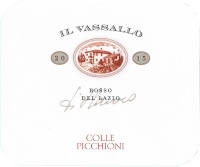
|
|
Il Vassallo 2015 |
|
| Colle Picchioni (Latium, Italy) | |
 Merlot (60%), Cabernet Sauvignon (30%), Cabernet Franc (10%) Merlot (60%), Cabernet Sauvignon (30%), Cabernet Franc (10%) | |
| Price: € 22.00 | Score: |
 Intense ruby red and nuances of garnet red, little transparency. Intense ruby red and nuances of garnet red, little transparency. Intense, clean, pleasing, refined and elegant, starts with hints of
black cherry, black currant and violet followed by aromas of plum,
blueberry, iris, tobacco, chocolate, pink pepper, graphite, vanilla and
eucalyptus. Intense, clean, pleasing, refined and elegant, starts with hints of
black cherry, black currant and violet followed by aromas of plum,
blueberry, iris, tobacco, chocolate, pink pepper, graphite, vanilla and
eucalyptus.
 Tannic attack and however balanced by alcohol, full body, intense
flavors, agreeable. Tannic attack and however balanced by alcohol, full body, intense
flavors, agreeable.
 Persistent finish with flavors of black cherry, black currant and plum. Persistent finish with flavors of black cherry, black currant and plum. Aged in barrique. Aged in barrique. |
|
 Game, Roasted meat, Stewed and braised meat, Hard cheese Game, Roasted meat, Stewed and braised meat, Hard cheese |
|
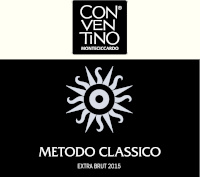
|
|
Metodo Classico Extra Brut 2015 |
|
| Il Conventino di Monteciccardo (Marches, Italy) | |
 Famoso Famoso | |
| Price: € 22.00 | Score: |
 Brilliant greenish yellow and nuances of greenish yellow, very
transparent, fine and persistent perlage. Brilliant greenish yellow and nuances of greenish yellow, very
transparent, fine and persistent perlage.
 Intense, clean, pleasing and refined, starts with hints of citrus
fruits, plum and apple followed by aromas of pear, broom, hawthorn, star
anise and hazelnut. Intense, clean, pleasing and refined, starts with hints of citrus
fruits, plum and apple followed by aromas of pear, broom, hawthorn, star
anise and hazelnut.
 Effervescent and crisp attack, however balanced by alcohol, good body,
intense flavors, agreeable. Effervescent and crisp attack, however balanced by alcohol, good body,
intense flavors, agreeable.
 Persistent finish with flavors of citrus fruits, apple and plum. Persistent finish with flavors of citrus fruits, apple and plum. Refermented in bottle on its lees for 24 months. Refermented in bottle on its lees for 24 months. |
|
 Fish and crustacean appetizers, Risotto with crustacean and vegetables, Fried fish, Dairy products Fish and crustacean appetizers, Risotto with crustacean and vegetables, Fried fish, Dairy products |
|
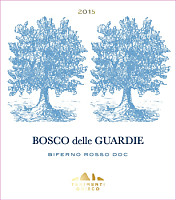
|
|
Biferno Rosso Bosco delle Guardie 2014 |
|
| Tenimenti Grieco (Molise, Italy) | |
 Montepulciano (80%), Aglianico (20%) Montepulciano (80%), Aglianico (20%) | |
| Price: € 10.40 | Score: |
 Intense ruby red and nuances of garnet red, little transparency. Intense ruby red and nuances of garnet red, little transparency. Intense, clean, pleasing and refined, starts with hints of black
cherry, blackberry and plum followed by aromas of violet, blueberry, carob,
tobacco, mace, vanilla and menthol. Intense, clean, pleasing and refined, starts with hints of black
cherry, blackberry and plum followed by aromas of violet, blueberry, carob,
tobacco, mace, vanilla and menthol.
 Properly tannic attack and however balanced by alcohol, good body,
intense flavors. agreeable. Properly tannic attack and however balanced by alcohol, good body,
intense flavors. agreeable.
 Persistent finish with flavors of black cherry, blackberry and plum. Persistent finish with flavors of black cherry, blackberry and plum. 12 months in cask, 4 months in bottle. 12 months in cask, 4 months in bottle. |
|
 Broiled meat and barbecue, Roasted meat, Stewed meat with mushrooms, Hard cheese Broiled meat and barbecue, Roasted meat, Stewed meat with mushrooms, Hard cheese |
|
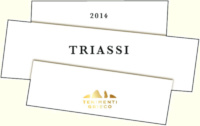
|
|
Triassi 2014 |
|
| Tenimenti Grieco (Molise, Italy) | |
 Cabernet Sauvignon (55%), Merlot (35%), Aglianico (10%) Cabernet Sauvignon (55%), Merlot (35%), Aglianico (10%) | |
| Price: € 20.00 | Score: |
 Intense ruby red and nuances of garnet red, little transparency. Intense ruby red and nuances of garnet red, little transparency. Intense, clean, pleasing, refined and elegant, starts with hints of
blackberry, plum and black currant followed by aromas of dried violet,
black cherry, blueberry, tobacco, chocolate, leather, carob, licorice,
mace, vanilla and menthol. Intense, clean, pleasing, refined and elegant, starts with hints of
blackberry, plum and black currant followed by aromas of dried violet,
black cherry, blueberry, tobacco, chocolate, leather, carob, licorice,
mace, vanilla and menthol.
 Properly tannic attack and however balanced by alcohol, full body,
intense flavors, pleasing roundness. Properly tannic attack and however balanced by alcohol, full body,
intense flavors, pleasing roundness.
 Persistent finish with flavors of blackberry, plum and black currant. Persistent finish with flavors of blackberry, plum and black currant. 21 months in barrique, 6 months in bottle. 21 months in barrique, 6 months in bottle. |
|
 Game, Roasted meat, Stewed and braised meat, Hard cheese Game, Roasted meat, Stewed and braised meat, Hard cheese |
|
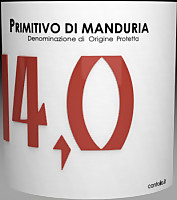
|
|
Primitivo di Manduria 14 di Terra 2016 |
|
| Cantolio (Apulia, Italy) | |
 Primitivo Primitivo | |
| Price: € 18.00 | Score: |
 Intense ruby red and nuances of garnet red, little transparency. Intense ruby red and nuances of garnet red, little transparency. Intense, clean, pleasing and refined, starts with hints of blackberry,
plum and violet followed by aromas of black cherry, blueberry, carob,
chocolate, tobacco, vanilla and menthol. Intense, clean, pleasing and refined, starts with hints of blackberry,
plum and violet followed by aromas of black cherry, blueberry, carob,
chocolate, tobacco, vanilla and menthol.
 Properly tannic attack and however balanced by alcohol, good body,
intense flavors, pleasing roundness. Properly tannic attack and however balanced by alcohol, good body,
intense flavors, pleasing roundness.
 Persistent finish with flavors of blackberry, plum and black cherry. Persistent finish with flavors of blackberry, plum and black cherry. Aged in steel tanks and barrique. Aged in steel tanks and barrique. |
|
 Roasted meat, Broiled meat and barbecue, Stewed meat, Hard cheese Roasted meat, Broiled meat and barbecue, Stewed meat, Hard cheese |
|

|
|
Primitivo di Manduria 15 di Mare 2016 |
|
| Cantolio (Piedmont, Italy) | |
 Primitivo Primitivo | |
| Price: € 19.00 | Score: |
 Intense ruby red and nuances of garnet red, little transparency. Intense ruby red and nuances of garnet red, little transparency. Intense, clean, pleasing and refined, starts with hints of blackberry,
black cherry and plum followed by aromas of violet, blueberry, carob,
cinnamon, chocolate, tobacco, mace, vanilla and menthol. Intense, clean, pleasing and refined, starts with hints of blackberry,
black cherry and plum followed by aromas of violet, blueberry, carob,
cinnamon, chocolate, tobacco, mace, vanilla and menthol.
 Properly tannic attack and however balanced by alcohol, full body,
intense flavors, pleasing roundness. Properly tannic attack and however balanced by alcohol, full body,
intense flavors, pleasing roundness.
 Persistent finish with flavors of blackberry, plum and black cherry. Persistent finish with flavors of blackberry, plum and black cherry. Aged in steel tanks and barrique. Aged in steel tanks and barrique. |
|
 Game, Roasted meat, Braised and stewed meat, Hard cheese Game, Roasted meat, Braised and stewed meat, Hard cheese |
|
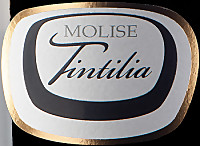
|
|
Molise Tintilia 2014 |
|
| Tenute Di Giulio (Molise, Italy) | |
 Tintilia Tintilia | |
| Price: € 19.90 | Score: |
 Intense ruby red and nuances of garnet red, little transparency. Intense ruby red and nuances of garnet red, little transparency. Intense, clean, pleasing and refined, starts with hints of blackberry,
plum and black cherry followed by aromas of violet, blueberry, lesser
calamint, chocolate, tobacco, cinnamon, vanilla and menthol. Intense, clean, pleasing and refined, starts with hints of blackberry,
plum and black cherry followed by aromas of violet, blueberry, lesser
calamint, chocolate, tobacco, cinnamon, vanilla and menthol.
 Properly tannic attack and however balanced by alcohol, good body,
intense flavors, agreeable. Properly tannic attack and however balanced by alcohol, good body,
intense flavors, agreeable.
 Persistent finish with flavors of blackberry, black cherry and plum. Persistent finish with flavors of blackberry, black cherry and plum. 6 months in barrique. 6 months in barrique. |
|
 Stuffed pasta, Broiled meat and barbecue, Roasted meat, Stewed meat with mushrooms, Hard cheese Stuffed pasta, Broiled meat and barbecue, Roasted meat, Stewed meat with mushrooms, Hard cheese |
|

|
|
Biferno Rosso Riserva Gironia 2010 |
|
| Borgo di Colloredo (Molise, Italy) | |
 Montepulciano (80%), Aglianico (20%) Montepulciano (80%), Aglianico (20%) | |
| Price: € 19.00 | Score: |
 Brilliant ruby red and nuances of garnet red, little transparency. Brilliant ruby red and nuances of garnet red, little transparency. Intense, clean, pleasing, refined and elegant, starts with hints of
plum, blackberry and dried violet followed by aromas of black cherry,
blueberry, carob, leather, cocoa, tobacco, licorice, mace, vanilla and
menthol. Intense, clean, pleasing, refined and elegant, starts with hints of
plum, blackberry and dried violet followed by aromas of black cherry,
blueberry, carob, leather, cocoa, tobacco, licorice, mace, vanilla and
menthol.
 Properly tannic attack and however balanced by alcohol, good body,
intense flavors, pleasing roundness. Properly tannic attack and however balanced by alcohol, good body,
intense flavors, pleasing roundness.
 Persistent finish with flavors of plum, blackberry and black cherry. Persistent finish with flavors of plum, blackberry and black cherry. 24 months in cask and barrique. 24 months in cask and barrique. |
|
 Roasted meat, Stewed meat with mushrooms, Broiled meat and barbecue, Hard cheese Roasted meat, Stewed meat with mushrooms, Broiled meat and barbecue, Hard cheese |
|

|
|
San Leonardo 2008 |
|
| Tenuta San Leonardo (Trentino, Italy) | |
 Cabernet Sauvignon (60%), Carménère (20%), Cabernet Franc (10%), Merlot (10%) Cabernet Sauvignon (60%), Carménère (20%), Cabernet Franc (10%), Merlot (10%) | |
| Price: € 55.00 | Score: |
 Intense ruby red and nuances of garnet red, little transparency. Intense ruby red and nuances of garnet red, little transparency. Intense, clean, pleasing, refined and elegant, starts with hints of
black currant, black cherry and plum followed by aromas of violet,
blueberry, peony, iris, chocolate, licorice, tobacco, leather, mace, cigar
box, pink pepper, vanilla and eucalyptus. Intense, clean, pleasing, refined and elegant, starts with hints of
black currant, black cherry and plum followed by aromas of violet,
blueberry, peony, iris, chocolate, licorice, tobacco, leather, mace, cigar
box, pink pepper, vanilla and eucalyptus.
 Tannic attack and however balanced by alcohol, full body, intense
flavors, agreeable. Tannic attack and however balanced by alcohol, full body, intense
flavors, agreeable.
 Very persistent finish with long flavors of black currant, plum and
black cherry. Very persistent finish with long flavors of black currant, plum and
black cherry.
 24 months in barrique, at least 12 months in bottle. 24 months in barrique, at least 12 months in bottle. |
|
 Game, Roasted meat, Braised and stewed meat, Hard cheese Game, Roasted meat, Braised and stewed meat, Hard cheese |
|
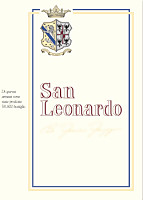
|
|
San Leonardo 2005 |
|
| Tenuta San Leonardo (Trentino, Italy) | |
 Cabernet Sauvignon (60%), Carménère (20%), Cabernet Franc (10%), Merlot (10%) Cabernet Sauvignon (60%), Carménère (20%), Cabernet Franc (10%), Merlot (10%) | |
| Price: € 55.00 | Score: |
 Brilliant ruby red and nuances of garnet red, little transparency. Brilliant ruby red and nuances of garnet red, little transparency. Intense, clean, pleasing, refined and elegant, starts with hints of
plum, black currant and dried violet followed by aromas of black cherry,
blueberry, peony, iris, cigar box, chocolate, green bean, cinnamon, tobacco,
licorice, vanilla and eucalyptus. Intense, clean, pleasing, refined and elegant, starts with hints of
plum, black currant and dried violet followed by aromas of black cherry,
blueberry, peony, iris, cigar box, chocolate, green bean, cinnamon, tobacco,
licorice, vanilla and eucalyptus.
 Tannic attack and however balanced by alcohol, full body, intense
flavors, agreeable. Tannic attack and however balanced by alcohol, full body, intense
flavors, agreeable.
 Very persistent finish with long flavors of plum, black currant and
black cherry. Very persistent finish with long flavors of plum, black currant and
black cherry.
 24 months in barrique, 18 months in bottle. 24 months in barrique, 18 months in bottle. |
|
 Game, Roasted meat, Stewed and braised meat, Hard cheese Game, Roasted meat, Stewed and braised meat, Hard cheese |
|
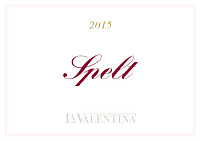
|
|
Montepulciano d'Abruzzo Riserva Spelt 2015 |
|
| La Valentina (Abruzzo, Italy) | |
 Montepulciano Montepulciano | |
| Price: € 15.15 | Score: |
 Brilliant ruby red and nuances of garnet red, little transparency. Brilliant ruby red and nuances of garnet red, little transparency. Intense, clean, pleasing, refined and elegant, starts with hints of
plum, black cherry and blueberry followed by aromas of violet, blackberry,
carob, tobacco, chocolate, mace, rosemary, licorice, vanilla and menthol. Intense, clean, pleasing, refined and elegant, starts with hints of
plum, black cherry and blueberry followed by aromas of violet, blackberry,
carob, tobacco, chocolate, mace, rosemary, licorice, vanilla and menthol.
 Properly tannic attack and however balanced by alcohol, good body,
intense flavors, agreeable. Properly tannic attack and however balanced by alcohol, good body,
intense flavors, agreeable.
 Persistent finish with flavors of plum, black cherry and blueberry. Persistent finish with flavors of plum, black cherry and blueberry. 16 months in cask and barrique, 12 months in bottle. 16 months in cask and barrique, 12 months in bottle. |
|
 Roasted meat, Broiled meat and barbecue, Stewed and braised meat with mushrooms, Hard cheese Roasted meat, Broiled meat and barbecue, Stewed and braised meat with mushrooms, Hard cheese |
|
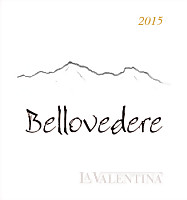
|
|
Montepulciano d'Abruzzo Riserva Terre dei Vestini Bellovedere 2015 |
|
| La Valentina (Abruzzo, Italy) | |
 Montepulciano Montepulciano | |
| Price: € 33.60 | Score: |
 Deep ruby red and nuances of garnet red, little transparency. Deep ruby red and nuances of garnet red, little transparency. Intense, clean, pleasing, refined and elegant, starts with hints of
plum, blackberry and black cherry followed by aromas of violet, blueberry,
black currant, tobacco, carob, cocoa, leather, licorice, mace, black
pepper, vanilla and eucalyptus. Intense, clean, pleasing, refined and elegant, starts with hints of
plum, blackberry and black cherry followed by aromas of violet, blueberry,
black currant, tobacco, carob, cocoa, leather, licorice, mace, black
pepper, vanilla and eucalyptus.
 Tannic attack and however balanced by alcohol, full body, intense
flavors, agreeable. Tannic attack and however balanced by alcohol, full body, intense
flavors, agreeable.
 Very persistent finish with flavors of plum, blackberry and black
cherry. Very persistent finish with flavors of plum, blackberry and black
cherry.
 18 months in cask and barrique, 12 months in bottle. 18 months in cask and barrique, 12 months in bottle. |
|
 Game, Roasted meat, Stewed and braised meat, Hard cheese Game, Roasted meat, Stewed and braised meat, Hard cheese |
|

|
|
Primitivo di Manduria Li Janni 2016 |
|
| Erminio Campa (Apulia, Italy) | |
 Primitivo Primitivo | |
| Price: € 14.00 | Score: |
 Deep ruby red and nuances of garnet red, little transparency. Deep ruby red and nuances of garnet red, little transparency. Intense, clean, pleasing and refined, starts with hints of plum,
blackberry and dried violet followed by aromas of black cherry, blueberry,
walnut husk, carob, juniper and thyme. Intense, clean, pleasing and refined, starts with hints of plum,
blackberry and dried violet followed by aromas of black cherry, blueberry,
walnut husk, carob, juniper and thyme.
 Properly tannic attack and however balanced by alcohol, good body,
intense flavors, agreeable. Properly tannic attack and however balanced by alcohol, good body,
intense flavors, agreeable.
 Persistent finish with flavors of plum, blackberry and black cherry. Persistent finish with flavors of plum, blackberry and black cherry. Aged in steel tanks. Aged in steel tanks. |
|
 Roasted meat, Stewed meat with mushrooms, Broiled meat and barbecue, Hard cheese Roasted meat, Stewed meat with mushrooms, Broiled meat and barbecue, Hard cheese |
|

|
|
Primitivo di Manduria Li Cameli 2016 |
|
| Erminio Campa (Piedmont, Italy) | |
 Primitivo Primitivo | |
| Price: € 23.50 | Score: |
 Intense ruby red and nuances of ruby red, little transparency. Intense ruby red and nuances of ruby red, little transparency. Intense, clean, pleasing and refined, starts with hints of blackberry,
plum and violet followed by aromas of black cherry, blueberry, raspberry,
carob, tobacco and menthol. Intense, clean, pleasing and refined, starts with hints of blackberry,
plum and violet followed by aromas of black cherry, blueberry, raspberry,
carob, tobacco and menthol.
 Properly tannic attack and however balanced by alcohol, good body,
intense flavors, pleasing roundness. Properly tannic attack and however balanced by alcohol, good body,
intense flavors, pleasing roundness.
 Persistent finish with flavors of blackberry, plum and black cherry. Persistent finish with flavors of blackberry, plum and black cherry. Aged in steel tanks. Aged in steel tanks. |
|
 Roasted meat, Broiled meat and barbecue, Stewed meat with mushrooms, Cheese Roasted meat, Broiled meat and barbecue, Stewed meat with mushrooms, Cheese |
|
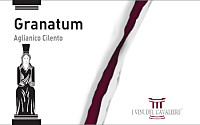
|
|
Cilento Aglianico Granatum 2016 |
|
| I Vini del Cavaliere - Cuomo (Campania, Italy) | |
 Aglianico Aglianico | |
| Price: € 13.00 | Score: |
 Deep ruby red and nuances of garnet red, little transparency. Deep ruby red and nuances of garnet red, little transparency. Intense, clean, pleasing and refined, starts with hints of blackberry,
black cherry and plum followed by aromas of dried violet, blueberry,
tobacco, chocolate, leather, vanilla, flint and menthol. Intense, clean, pleasing and refined, starts with hints of blackberry,
black cherry and plum followed by aromas of dried violet, blueberry,
tobacco, chocolate, leather, vanilla, flint and menthol.
 Properly tannic attack and however balanced by alcohol, good body,
intense flavors, agreeable. Properly tannic attack and however balanced by alcohol, good body,
intense flavors, agreeable.
 Persistent finish with flavors of blackberry, plum and black cherry. Persistent finish with flavors of blackberry, plum and black cherry. 6 months in barrique. 6 months in barrique. |
|
 Roasted meat, Stewed meat with mushrooms, Broiled meat and barbecue, Hard cheese Roasted meat, Stewed meat with mushrooms, Broiled meat and barbecue, Hard cheese |
|
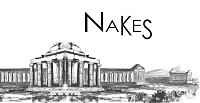
|
|
Nakes 2015 |
|
| I Vini del Cavaliere - Cuomo (Campania, Italy) | |
 Aglianico Aglianico | |
| Price: € 20.00 | Score: |
 Brilliant ruby red and nuances of garnet red, little transparency. Brilliant ruby red and nuances of garnet red, little transparency. Intense, clean, pleasing and refined, starts with hints of blackberry,
black cherry and plum followed by aromas of violet, blueberry, tobacco,
carob, chocolate, mace, vanilla and menthol. Intense, clean, pleasing and refined, starts with hints of blackberry,
black cherry and plum followed by aromas of violet, blueberry, tobacco,
carob, chocolate, mace, vanilla and menthol.
 Properly tannic attack and however balanced by alcohol, good body,
intense flavors, agreeable. Properly tannic attack and however balanced by alcohol, good body,
intense flavors, agreeable.
 Persistent finish with flavors of blackberry, black cherry and plum. Persistent finish with flavors of blackberry, black cherry and plum. 15 months in barrique. 15 months in barrique. |
|
 Broiled meat and barbecue, Roasted meat, Stewed meat with mushrooms, Hard cheese Broiled meat and barbecue, Roasted meat, Stewed meat with mushrooms, Hard cheese |
|

|
|
Colli di Faenza Sangiovese Col Mora 2015 |
|
| Rontana (Emilia Romagna, Italy) | |
 Sangiovese Sangiovese | |
| Price: € 14.00 | Score: |
 Brilliant ruby red and nuances of garnet red, little transparency. Brilliant ruby red and nuances of garnet red, little transparency. Intense, clean, pleasing and refined, starts with hints of black
cherry, raspberry and plum followed by aromas of violet, cyclamen,
blueberry, blackberry, rose, carob and menthol. Intense, clean, pleasing and refined, starts with hints of black
cherry, raspberry and plum followed by aromas of violet, cyclamen,
blueberry, blackberry, rose, carob and menthol.
 Properly tannic attack and however balanced by alcohol, good body,
intense flavors, pleasing crispness. Properly tannic attack and however balanced by alcohol, good body,
intense flavors, pleasing crispness.
 Persistent finish with flavors of black cherry, raspberry and plum. Persistent finish with flavors of black cherry, raspberry and plum. 18 months in steel tanks, 18 months in bottle. 18 months in steel tanks, 18 months in bottle. |
|
 Stuffed pasta with mushrooms, Sauteed meat, Cold cuts, Cheese Stuffed pasta with mushrooms, Sauteed meat, Cold cuts, Cheese |
|
News |
|
In this section are published news and information about events concerning the world of wine and food. Whoever is interested in publishing this kind of information can send us a mail to our address.
|
AquavitaeReview of Grappa, Distillates and Brandy |
|
|
||||||||||||
Wine Guide ParadeJanuary 2019
|
| |||||||
Privacy Policy | |||||||


| Copyright © 2002-2024 Antonello Biancalana, DiWineTaste - All rights reserved |
| All rights reserved under international copyright conventions. No part of this publication and of this WEB site may be
reproduced or utilized in any form or by any means, electronic or mechanical, without permission in writing from DiWineTaste. |